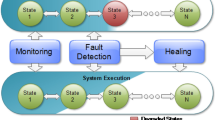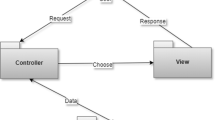Abstract
As the size and complexity of software systems increase, the design and specification of overall system structure become more significant issues than the choice of algorithms and data structures of computation. An appropriate architecture for a system is a key element of its success. Based on the practice of Jadebird software production line, this paper proposes a software architectural style based on hierarchical message buses, named JB/HMB. In this style, the component model consists of external interfaces, static structure and dynamic behavior, which depicts a component from different aspects. Supported by message buses, components interact with one another by messages, which can be used to describe distributed and concurrent systems well. JB/HMB style supports stepwise decomposition and refinement, and runtime system evolution. Finally, characteristics of JB/HMB style are summarized as a conclusion, and future research directions are specified.
Similar content being viewed by others
References
Shaw, M., Garlan, D., Software Architecture: Perspectives on an Emerging Discipline, Upper Saddle River: Prentice Hall, 1996.
Bass, L., Clements, P., Kazman, R., Software Architecture in Practice, Reading: Addison-Wesley Publishing Company, 1997.
Buschmann, F., Meunier, R., Rohnert, H. et al., Pattern-Oriented Software Architecture: A System of Patterns, New York: John Wiley & Sons Ltd., 1996.
Taylor, R., Medvidovic, N., Anderson, K. et al., A component-and message-based architectural style for GUI software, IEEE Transactions on Software Engineering, June 1996, 22(6): 390–406.
Yang Fuqing, Selected Papers of Fuqing Yang (in Chinese), Beijing: Peking University Press, 1998.
Zhang Shikun, Wang Lifu, Chang Xin, et al., Hierarchical message bus-based software architecture description language, Journal of Electronics (in Chinese), May 2001, 29(5): 581–584.
Pressman, R., Software Engineering, A Practitioner’s Approach, Fourth Edition, New York: The McGraw-Hill Companies, Inc., 1997.
Rumbaugh, J., Blaha, M., Premerlani, W. et al., Object-Oriented Modeling and Design, Prentice Hall, 1991.
Luckham, D., Vera, J., Meldal, S., Three Concepts of System Architecture, CSL-TR-95-674, Stanford: Stanford University, July, 1995.
Hopcroft, J., Ullman, J., Introduction to Automata Theory, Languages, and Computation, Reading: Addison-Wesley Publishing Company, 1979.
Booch, G., Rumbaugh, J., Jacobson, I., The Unified Modeling Language User Guide, Reading: Addison-Wesley Publishing Company, 1998.
Oreizy, P., Medvidovic, N., Taylor, R., Architecture-based runtime software evolution, in Proceedings of the International Conference on Software Engineering(ICSE), April 1998, Kyoto, Japan, 177–186.
Zhang Shikun, A study on hierarchical message bus based software architecture, Doctoral Dissertation, Beijing: Department of Computer Science and Technology, Peking University, June 2000.
Author information
Authors and Affiliations
Corresponding author
Rights and permissions
About this article
Cite this article
Zhang, S., Wang, L. & Yang, F. Hierarchical message bus-based software architectural style. Sci China Ser F 45, 111–120 (2002). https://doi.org/10.1360/02yf9009
Received:
Issue Date:
DOI: https://doi.org/10.1360/02yf9009




